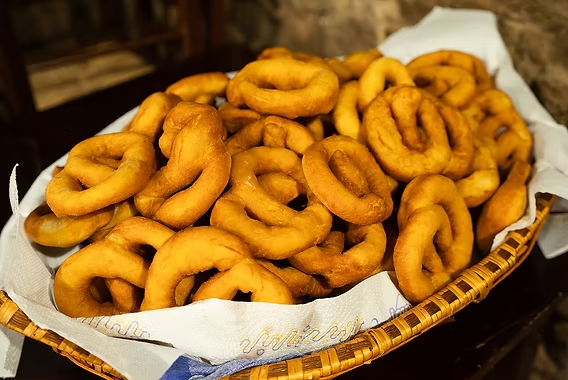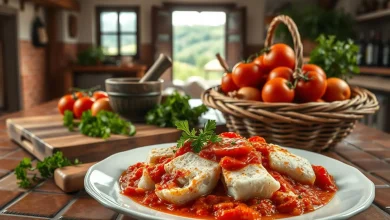Crescentine (or Tigelle): A Delicious Italian Flatbread Recipe
Crescentine, also known as tigelle, are a traditional Italian flatbread that originates from the Emilia-Romagna region. Soft and slightly chewy, these small round flatbreads are typically enjoyed warm and can be served as an appetizer, a side dish, or even as a main course when filled with various savory ingredients. Whether you’re serving them as an accompaniment to meats, cheeses, or vegetables, crescentine will surely elevate any meal with their deliciously comforting texture and flavor.
This recipe will guide you through making these delightful Italian treats at home. While traditionally cooked in a special tigelliera (a two-sided cast-iron griddle), they can also be made using a non-stick skillet or grill pan. With their tender crumb and golden, crispy exterior, these crescentine are best served warm, fresh off the grill, and filled with your favorite toppings. So, let’s dive into this delightful recipe that will yield 18 pieces of these delightful little bites.
Crescentine (or Tigelle) Recipe
Category: Leavened Breads
Servings/Pieces: 18
Preparation Time: 30 minutes (excluding rest time)
Resting Time: 2 hours
Cooking Time: 8-10 minutes
Ingredients
| Ingredient | Quantity |
|---|---|
| Farina 0 (Type 0 flour) | 250g |
| Farina 00 (Type 00 flour) | 500g |
| Whole milk | 300g |
| Water | 200g |
| Lard | 60g |
| Extra virgin olive oil | 50g |
| Dry yeast | 3g |
| Fine salt | 1 teaspoon |
Nutritional Information (per serving)
| Nutrient | Amount |
|---|---|
| Calories | 150 kcal |
| Carbohydrates | 25g |
| Protein | 4g |
| Fat | 5g |
| Saturated Fat | 2g |
| Fiber | 1g |
| Sugar | 2g |
| Sodium | 300mg |
(Note: Nutritional values are estimates and may vary based on ingredient brands and portion sizes.)
Instructions
-
Prepare the Dough:
- Start by placing the farina 0 and farina 00 flours in the bowl of your stand mixer. Mix them together to ensure they are well combined.
- In a separate container, heat the whole milk and water until lukewarm, just slightly warmer than room temperature, then sprinkle the dry yeast into the liquid. Stir gently and let it sit for a few minutes to activate the yeast.
-
Mix the Dough:
- Once the yeast is activated, pour the mixture into the flour. Add the lard and extra virgin olive oil to the bowl as well. Begin mixing on low speed with the dough hook attachment for about 1 minute to incorporate the ingredients.
- After this initial mix, increase the speed and continue kneading for about 6 minutes, or until the dough becomes smooth and elastic. The dough should be slightly sticky but firm enough to hold its shape.
-
Knead and Rest the Dough:
- Transfer the dough onto a lightly floured work surface. Knead it by hand for a few more minutes until it becomes smooth, soft, and homogeneous.
- Shape the dough into a ball and place it in a large bowl. Cover the bowl with plastic wrap or a clean kitchen towel and allow it to rest at room temperature for about 2 hours. The dough should double in size during this time.
-
Shape the Crescentine:
- After the dough has rested, punch it down to release any air bubbles. Turn it out onto a floured work surface and gently roll it out with a rolling pin to a thickness of about 5 mm (1/4 inch).
- Using a round cutter or a glass with a diameter of about 8.5 cm (3.5 inches), cut out as many circles as you can from the dough. Gather the excess dough, roll it out again, and continue cutting until all the dough is used up.
-
Rest the Dough Circles:
- Place the cut dough circles on a parchment-lined tray or baking sheet. Cover them with a clean kitchen towel and let them rest for an additional 20 minutes. This resting time will help the dough rise slightly, ensuring a fluffier texture.
-
Preheat the Tigelliera (or Griddle):
- If you are using a tigelliera, heat it over medium heat for about 5 minutes, making sure both sides of the griddle are hot.
- If you don’t have a tigelliera, you can use a non-stick skillet or a cast-iron griddle to cook the crescentine. Just make sure the pan is preheated and hot before cooking.
-
Cook the Crescentine:
- Once the tigelliera is preheated, place the dough circles inside. You should be able to fit a few at a time, depending on the size of your griddle.
- Close the lid of the tigelliera and cook the crescentine for about 4-5 minutes on one side. Then, flip the griddle over to check the cooking progress. If the crescentine are still too pale, flip them back and cook for another few minutes until they are golden brown on both sides.
- Repeat with the remaining dough circles, making sure each crescentina gets cooked through. Be patient with the cooking process, as the key is slow and even cooking to avoid undercooked centers.
-
Rest and Serve:
- Once the crescentine are perfectly golden and cooked, remove them from the tigelliera and place them on a clean kitchen towel to keep them warm. Cover them with the towel to preserve their softness and allow them to continue cooking slightly from the residual heat.
- Let them rest for a few minutes before serving. You can slice them open like a sandwich and stuff them with your favorite fillings.
Serving Suggestions
Crescentine (or tigelle) are versatile and can be served in a variety of ways. Here are some filling ideas:
- Traditional Emilian Fillings: Fill the crescentine with prosciutto, salamino (Italian salami), and a generous spread of stracchino cheese (a soft, creamy cheese).
- Vegetarian Option: Opt for a spread of pesto with roasted vegetables such as zucchini, eggplant, and peppers for a fresh, vibrant filling.
- Cheese Lovers: Try a mixture of ricotta, mozzarella, and fresh herbs like basil or oregano for a creamy, savory bite.
- Sweet Option: For a sweet treat, spread a little nutella or jam between the halves and enjoy as a dessert.
Storage Tips
While these crescentine are best enjoyed fresh and warm, you can store leftovers in an airtight container at room temperature for up to 2 days. To reheat, simply warm them on a griddle or in a skillet for a few minutes to bring back their crispy exterior.
Conclusion
These crescentine (or tigelle) are not just a delightful treat for any occasion; they embody the spirit of traditional Italian cooking, bringing comfort and joy with every bite. Soft, slightly chewy, and perfectly golden on the outside, they can be enjoyed as-is or stuffed with various fillings to suit your taste. Whether you’re preparing a meal for family, friends, or a special event, these crescentine are sure to impress.
Perfect for pairing with meats, cheeses, and vegetables, or even a touch of sweetness, this recipe is a beautiful way to experience the tastes of Italy at home. Enjoy the process, and most importantly, enjoy your crescentine warm and fresh out of the pan!







